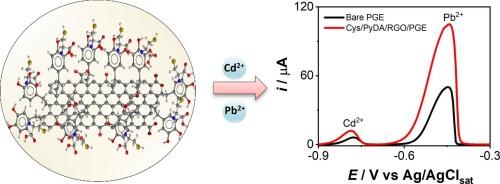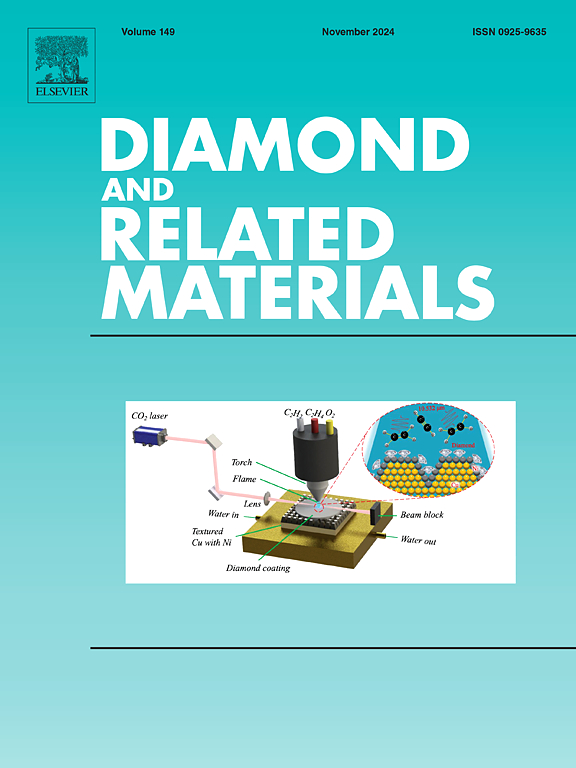A three-components-based disposable electrochemical sensor for the detection of heavy metal ions in water
IF 4.3
3区 材料科学
Q2 MATERIALS SCIENCE, COATINGS & FILMS
引用次数: 0
Abstract
The development of an efficient sensor based on a novel three-components nanocomposite is presented for the detection of heavy metal ions (Cd2+ and Pb2+) in water. For the preparation of three-components nanocomposite surface, the polydopamine reduced graphene oxide (PyDA/RGO) composite was initially prepared by a one-step polymerization of dopamine (DA) on RGO followed by surface modification of the prepared composite with cysteine (Cys). The formation of three-components nanocomposite surface (i.e., Cys/PyDA/RGO) was initially confirmed through physical characterization techniques, including X-ray diffraction and infrared spectroscopy, whereas scanning electron microscopy revealed the surface morphology after each step of sensor fabrication. The electrochemical properties of the sensing platform were evaluated through electrochemical techniques, including cyclic voltammetry and electrochemical impedance spectroscopy with an external ferri‐−/ferrocyanide redox probe. The prepared three-components nanocomposite on disposable pencil graphite electrode (Cys/PyDA/RGO/PGE) showed an improved charge transfer rate as compared to PyDA/RGO/PGE and bare PGE electrode. Targeted heavy metal ions were detected on the sensor surface using differential pulse voltammetry with greater sensitivity, showing detection limits of 0.77 and 1.13 ppb for Cd+2 and Pb+2 ions in citrate buffer solution, respectively. The sensor demonstrated comparable performance in the tap water samples.

基于三组件的一次性电化学传感器用于检测水中的重金属离子
本文介绍了一种基于新型三组分纳米复合材料的高效传感器的开发情况,该传感器用于检测水中的重金属离子(Cd2+ 和 Pb2+)。在制备三组分纳米复合材料表面时,首先在 RGO 上一步聚合多巴胺(DA),然后用半胱氨酸(Cys)对制备的复合材料进行表面修饰,制备出多多巴胺还原氧化石墨烯(PyDA/RGO)复合材料。通过 X 射线衍射和红外光谱等物理表征技术初步确认了三组分纳米复合材料(即 Cys/PyDA/RGO)表面的形成,而扫描电子显微镜则显示了传感器制造的每个步骤后的表面形态。传感平台的电化学特性通过电化学技术进行了评估,包括循环伏安法和使用外部铁/铁氰化物氧化还原探针的电化学阻抗光谱法。与 PyDA/RGO/PGE 和裸 PGE 电极相比,在一次性铅笔石墨电极上制备的三组分纳米复合材料(Cys/PyDA/RGO/PGE)显示出更高的电荷转移率。使用微分脉冲伏安法在传感器表面检测目标重金属离子具有更高的灵敏度,柠檬酸缓冲溶液中 Cd+2 和 Pb+2 离子的检测限分别为 0.77 和 1.13 ppb。该传感器在自来水样品中的性能相当。
本文章由计算机程序翻译,如有差异,请以英文原文为准。
求助全文
约1分钟内获得全文
求助全文
来源期刊

Diamond and Related Materials
工程技术-材料科学:综合
CiteScore
6.00
自引率
14.60%
发文量
702
审稿时长
2.1 months
期刊介绍:
DRM is a leading international journal that publishes new fundamental and applied research on all forms of diamond, the integration of diamond with other advanced materials and development of technologies exploiting diamond. The synthesis, characterization and processing of single crystal diamond, polycrystalline films, nanodiamond powders and heterostructures with other advanced materials are encouraged topics for technical and review articles. In addition to diamond, the journal publishes manuscripts on the synthesis, characterization and application of other related materials including diamond-like carbons, carbon nanotubes, graphene, and boron and carbon nitrides. Articles are sought on the chemical functionalization of diamond and related materials as well as their use in electrochemistry, energy storage and conversion, chemical and biological sensing, imaging, thermal management, photonic and quantum applications, electron emission and electronic devices.
The International Conference on Diamond and Carbon Materials has evolved into the largest and most well attended forum in the field of diamond, providing a forum to showcase the latest results in the science and technology of diamond and other carbon materials such as carbon nanotubes, graphene, and diamond-like carbon. Run annually in association with Diamond and Related Materials the conference provides junior and established researchers the opportunity to exchange the latest results ranging from fundamental physical and chemical concepts to applied research focusing on the next generation carbon-based devices.
 求助内容:
求助内容: 应助结果提醒方式:
应助结果提醒方式:


